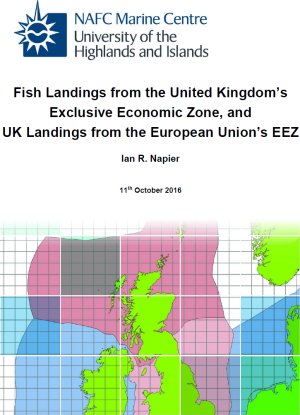EEZ-Report-2016-10-11
Fish Landings from the United Kingdom’s Exclusive Economic Zone, and UK Landings from the European Union’s EEZ
content
Fish Landings from the United Kingdom’s Exclusive Economic Zone, and UK Landings from the European Union’s EEZ
11th October 2016

An analysis of fisheries data was carried out at the request of the Shetland Fishermen’s Association (SFA). The scope of the request was to determine, so far as was possible using available data:
- The quantity of fish caught within the United Kingdom’s Exclusive Economic Zone (EEZ) by fishing boats of other European Union member states; and,
- The quantity of fish caught by UK fishing boats elsewhere in the European Union’s Exclusive Economic Zone.
The Exclusive Economic Zone is a sea area defined in International Law that extends up to 200 nautical miles (371 km) from the coast, within which a country is entitled to control the exploitation of fish and shellfish, as well as other economic resources.
Download the Report
Summary
On average, for the years from 2012 to 2014, it is estimated that:
- More than half (58%) of the fish and shellfish landed from the United Kingdom’s Exclusive Economic Zone (EEZ) by European Union fishing boats was caught by non-UK boats.
- Non-UK European fishing boats landed 650,000 tonnes of fish and shellfish from the United Kingdom’s EEZ, worth £408 million, each year. This included 99,000 tonnes (£179 million) of demersal fish, 424,000 tonnes (£183 million) of pelagic fish, 16,000 tonnes (£34 million) of shellfish, and 111,000 tonnes (£11 million) of industrial fish.
- UK fishing boats landed 90,000 tonnes of fish and shellfish, worth £103 million, from other areas of the European Union’s EEZ each year.
- Non-UK European fishing boats landed 560,000 tonnes (worth £300 million) more fish and shellfish from the United Kingdom’s EEZ each year than UK fishing boats landed from elsewhere in the European Union’s EEZ.
- Non-UK European fishing boats landed seven times more fish and shellfish (by weight) from the United Kingdom’s EEZ than UK boats did from other areas of the EU’s EEZ, and four times more by value.
- Half of the demersal fish, almost two-thirds of the pelagic fish and almost all of the industrial fish landed from the United Kingdom’s EEZ by European Union fishing boats were caught by non-UK boats.
- More than half of the megrim, plaice and saithe, three-quarters of the common (Dover) sole, hake, herring and skates and rays, 83% of the horse mackerel and 94% of the blue whiting landed from the United Kingdom’s EEZ by European Union fishing boats were caught by non-UK boats.
Scottish Part of the UK EEZ
- More than half (51%) of the fish and shellfish landed from the Scottish part of the United Kingdom’s Exclusive Economic Zone (EEZ) by European Union fishing boats was caught by non-UK boats.
- Non-UK European fishing boats landed 386,000 tonnes of fish and shellfish from the Scottish part of the UK EEZ, worth £210 million, each year.
- One-third of the demersal fish, more than half of the pelagic fish and almost all of the industrial fish landed from the Scottish part of the UK EEZ by European Union fishing boats were caught by non-UK boats.
- More than half of the hake and saithe, almost three-quarters of the herring, 86% of the horse mackerel and 94% of the blue whiting landed from the Scottish part of the UK EEZ by European Union fishing boats were caught by non-UK boats.
English, Welsh and Northern Irish Part of the UK EEZ
- Almost three-quarters (71%) of the fish and shellfish landed from the English, Welsh and Northern Irish part of the United Kingdom’s Exclusive Economic Zone (EEZ) by European Union fishing boats was caught by non-UK boats.
- Non-UK European fishing boats landed 260,000 tonnes of fish and shellfish from the English, Welsh and Northern Irish part of the UK EEZ, worth almost £200 million, each year.
- Almost three-quarters of the demersal fish, more than three-quarters of the pelagic fish and almost all of the industrial fish landed from the English, Welsh and Northern Irish part of the UK EEZ by European Union fishing boats were caught by non-UK boats.
- More than half of the ling, monks, plaice and saithe, three-quarters of the cod, common (Dover) sole, haddock, hake, megrim, skates and rays, and whiting, 80% of the horse mackerel and mackerel, and 85% of the herring landed from the English, Welsh and Northern Irish part of the UK EEZ by European Union fishing boats were caught by non-UK boats.
Contact
Please direct enquiries to Dr Ian Napier.